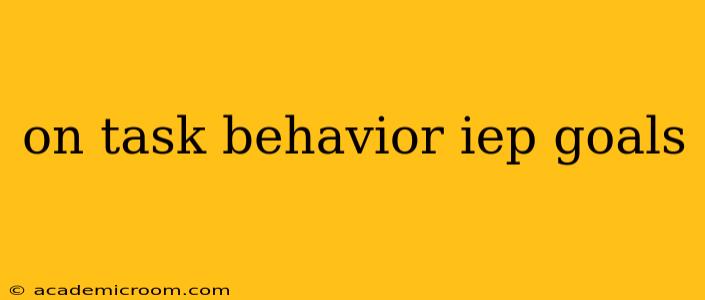Creating effective Individualized Education Program (IEP) goals for on-task behavior requires a nuanced understanding of the student's specific needs and challenges. This guide provides a framework for developing measurable, achievable, and relevant goals, ensuring students stay focused and engaged in their learning. We'll delve into the specifics, addressing common questions and offering examples to help you craft impactful IEP goals.
What are On-Task Behavior IEP Goals?
On-task behavior IEP goals focus on increasing a student's ability to stay focused and engaged in learning activities. These goals address the behaviors that interfere with learning, such as off-task behaviors, inattention, disruptiveness, and lack of participation. They are crucial for academic success and overall classroom participation. Effective goals are tailored to the individual student, considering their strengths, weaknesses, and specific learning environment.
How to Write Effective On-Task Behavior IEP Goals
Effective IEP goals follow the SMART criteria: Specific, Measurable, Achievable, Relevant, and Time-bound.
- Specific: Clearly define the target behavior. Instead of "improve focus," specify what "improve focus" looks like. For example, "remain seated and attending to teacher instruction for 15 minutes."
- Measurable: Use quantifiable metrics to track progress. How will you measure success? This could involve frequency, duration, or percentage of time on-task.
- Achievable: Set realistic goals considering the student's current abilities and challenges. Start with smaller, achievable goals and gradually increase the difficulty.
- Relevant: Goals must directly relate to the student's educational needs and learning objectives.
- Time-bound: Establish a timeframe for achieving the goal. This could be a short-term goal (e.g., within a month) or a long-term goal (e.g., by the end of the school year).
Examples of On-Task Behavior IEP Goals
Here are some examples of well-written on-task behavior IEP goals, demonstrating the SMART criteria:
Example 1 (Focusing on Duration):
- Goal: Given verbal prompts from the teacher, [Student's Name] will remain on-task (engaged in assigned activities) for 20 minutes during independent work periods, as measured by direct observation, for 80% of sessions during the next marking period.
Example 2 (Focusing on Frequency):
- Goal: During whole-group instruction, [Student's Name] will exhibit off-task behaviors (e.g., talking out of turn, getting out of seat) no more than twice per 30-minute session, as measured by teacher observation, in 4 out of 5 observation periods during the next grading period.
Example 3 (Focusing on Specific Activities):
- Goal: During reading group activities, [Student's Name] will participate actively by answering at least 2 questions per session and following along with the text (as measured by teacher observation), on 4 out of 5 days each week for the next six weeks.
Addressing Common Questions about On-Task Behavior IEP Goals
What strategies can be incorporated to improve on-task behavior?
Strategies for improving on-task behavior are varied and should be tailored to the individual student. Common strategies include:
- Positive reinforcement: Rewarding on-task behavior with praise, privileges, or tangible rewards.
- Visual supports: Using visual timers, checklists, or schedules to help students track their progress and stay organized.
- Behavioral interventions: Implementing strategies such as positive behavior interventions and supports (PBIS) to address underlying behavioral issues.
- Environmental modifications: Adjusting the classroom environment to minimize distractions and create a more conducive learning space.
- Self-monitoring techniques: Teaching students to monitor their own behavior and identify triggers for off-task behavior.
- Sensory strategies: Addressing sensory sensitivities that may be contributing to difficulty focusing.
How frequently should on-task behavior be monitored?
The frequency of monitoring will depend on the student's needs and the severity of the behavior. Regular monitoring, such as daily observation or progress tracking, is essential to ensure the effectiveness of the interventions and adjust the IEP goals as needed.
What if the student isn't making progress toward their on-task behavior goals?
If the student is not making progress, it's crucial to re-evaluate the IEP goals, interventions, and strategies. This might involve:
- Adjusting the goals: Making the goals less challenging or focusing on smaller, more attainable steps.
- Modifying the interventions: Trying different strategies to address the behavior.
- Consulting with specialists: Seeking input from specialists such as school psychologists or behavioral therapists.
- Increasing the frequency of monitoring: More frequent monitoring can provide a clearer picture of the student's progress and identify areas needing further attention.
By following these guidelines and collaborating with the IEP team, you can develop effective on-task behavior IEP goals that support students' academic success and overall well-being. Remember, consistent monitoring and adjustments are key to success.
